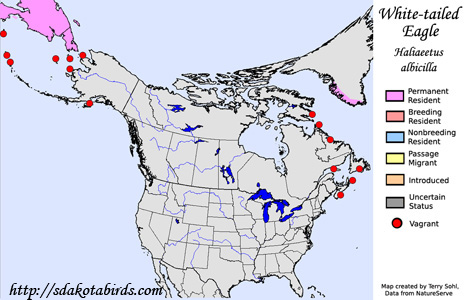| Length: 30 - 36 inches | Wingspan: 6 to 8 feet | Seasonality: Non-resident in South Dakota |
| ID Keys: White tail, dark plumage overall, very large size | ||
 The
White-tailed Eagle is a very large raptor with a widespread Eurasian Range.
They are often considered the Old World equivalent of our
Bald Eagle, a species to which they are
closely related. In the western Hemisphere, small numbers breed in
southwestern Greenland, and the species has also nested on Attu Island on
the far western edge of Alaska's Aleutian chain. Strays have been
spotted in other locations on the North American coastline, with historical
sightings once occurring as far south as Cape Cod in Massachusetts.
Populations were depleted by the mid 20th-century, but protective measure
have led to a modest rebound in populations in recent years. Once
listed as "Near Threatened" by the IUCN, White-tailed Eagles are now
considered a species of "Least Concern". They are also sometimes
called the White-tailed Sea Eagle, especially in their normal Eurasian
range.
The
White-tailed Eagle is a very large raptor with a widespread Eurasian Range.
They are often considered the Old World equivalent of our
Bald Eagle, a species to which they are
closely related. In the western Hemisphere, small numbers breed in
southwestern Greenland, and the species has also nested on Attu Island on
the far western edge of Alaska's Aleutian chain. Strays have been
spotted in other locations on the North American coastline, with historical
sightings once occurring as far south as Cape Cod in Massachusetts.
Populations were depleted by the mid 20th-century, but protective measure
have led to a modest rebound in populations in recent years. Once
listed as "Near Threatened" by the IUCN, White-tailed Eagles are now
considered a species of "Least Concern". They are also sometimes
called the White-tailed Sea Eagle, especially in their normal Eurasian
range.
Habitat: For breeding, White-tailed Eagles require areas with broad expanses of coastline, in conjunction with cliff faces or tall trees for nesting.
Diet: Feeds on a variety of prey, including seabirds and freshwater birds, fish, and small to medium-sized mammals. Many birds also specialize in carrion, particularly outside of the breeding season.
Behavior: When feeding on fish, White-tailed Eagles typically cruise in a slow flight, dipping down to the water's surface to grab fish while in flight. Much of its hunting is also done by patiently observing from a prominent perch, and swooping down for prey when it is spotted. Like their North American counterparts, the Bald Eagle, White-tailed Eagles will also sometimes engage in thievery of prey items from other birds and animals.
Nesting: White-tailed Eagles mate for life, maintaining a permanent home range and using the same nest site year after year. Subsequent generations may end up "inheriting" the same general home range, resulting in nests and home ranges that may be used for many successive decades. The nest is an extremely large structure built of sticks and branches, often lined with softer vegetative material, and may reach 6 feet or more across in size. The nest is constructed on a cliff or in a large tree. Two eggs are typically laid, and both parents help to incubate the eggs and raise the young.
Migration: Adult birds are typically considered permanent residents, although they will make short movements to take advantage of feeding opportunities. Young birds may disperse widely after fledging, but settle into a permanent home range when they begin breeding.
Interactive eBird map: Click here to access an interactive eBird map of White-tailed Eagle sightings
Similar Species: Similar to Bald Eagle, Steller's Sea-Eagle.
Conservation Status: The White-tailed Eagle is currently listed as a species of "Least Concern" by the IUCN. However, populations are no doubt far below historical levels. Populations were severely reduced through the first half of the 20th century, and have since started to recover in parts of their range. Numbers have been increasing in recent decades, although habitat loss and poisoning continue to be problems in parts of its range.
Further Information: 1) BirdGuides.com - White-tailed Eagle
2) BirdLife International - White-tailed Eagle
3) Arkive.org - White-tailed Eagle
Photo Information: Photo by Paul Lewin - April 22nd, 2011 - Thirsk, England - Photo licensed under Creative Commons Attribution 2.0 Generic License
| Click below for a higher-resolution map |
 |
| South Dakota Status: Non-resident in South Dakota |
Additional White-tailed Eagle Photos (coming soon!!)
